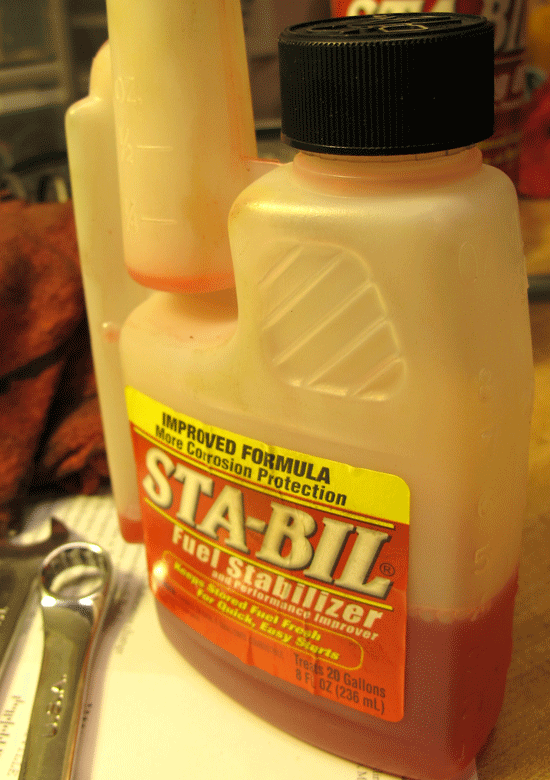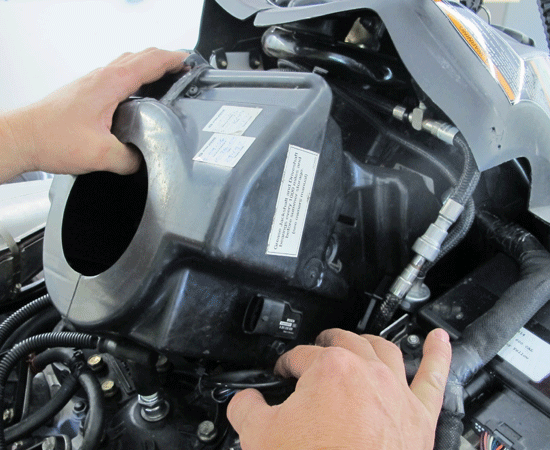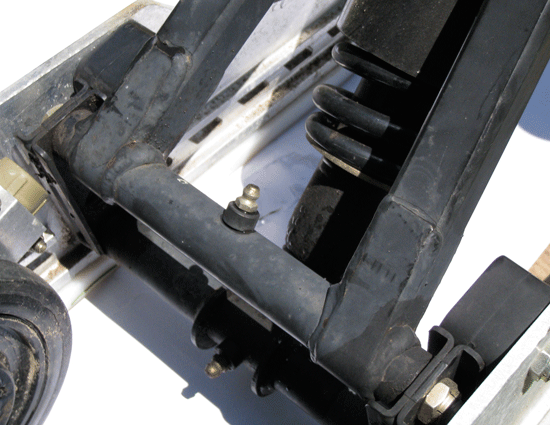- Staff
- #1
- Joined
- Oct 21, 2006
- Messages
- 48,007
- Reaction score
- 32,148
- Location
- Edmonton/Sherwood Park
- Website
- www.bumpertobumper.ca
[h=1]Snowmobile Off-Season Storage: How To Prep A Sled For Summer[/h]
Andy Swanson
April 1, 2014
Filed under How To, Top Stories

Spending about an hour in the spring to prep a snowmobile for off-season storage will keep it reliable and fun to ride well into the future, not to mention help retain its value. Without proper preparation and protection, snowmobile fuel hoses will harden, seat fabrics will dry out and crack, and rust will form on internal engine components. Corrosion will also form inside metal cross-shafts and tubes in the rear suspension, which could cause those parts to bind. Decals will crack and peel, and the shiny finish on the tunnel will turn into a dull, chalky layer of ‘blah.’ To prep for snowmobile off-season storage, you’ll need a can of engine fogging oil, a few ounces of fuel stabilizer, grease, simple hand tools, aerosol lubricant and an indoor place for the snowmobile to rest until fall.
 Gasoline typically requires 2.5 ounces of fuel stabilizer per 1 gallon of fuel.
Gasoline typically requires 2.5 ounces of fuel stabilizer per 1 gallon of fuel.
Snowmobile Off-Season Storage: Fuel Treatment
Treat the gasoline with fuel stabilizer to reduce the chance that the carburetors will be plugged with gunk. Gasoline contains solvents that make it volatile, but when those solvents evaporate the vapors rise from the carburetor bowl and can cause metal carburetor parts to corrode: The green gunk you’ve maybe seen in the bowl of a carburetor is remnant of fuel and corroded metal that ran down the body of the carburetor and settled at the lowest point. Fuel injected engines don’t usually suffer from this condition because throttle bodies, typically, are airtight.
Fuel stabilizers are designed to reduce evaporation of solvents that make gas volatile. While using too much stabilizer won’t necessarily harm the fuel system, fuel additives inherently reduce the octane rating of fuel by “watering down” the concentration, so follow directions on the container to add the correct amount of stabilizer in relation to how much fuel is in the tank.
Snowmobile Off-Season Storage: Fog The Engine
Coating the inside of a snowmobile’s engine with storage fogging oil is an important step to prevent crankshaft failure. The thin layer of oil protects the connecting rods, rod pins, cylinder walls and crankshaft bearings from air and moisture that will otherwise work together to cause corrosion and makes those parts susceptible to failure.
 Removing the air box varies by brand and model. It’s fairly easy to access the throat of carburetors or throttle bodies on older sleds, but many newer machines are tricky due to tight spaces that are packed with wires, hoses and cables. Work carefully as you remove parts and make note of their orientation.
Removing the air box varies by brand and model. It’s fairly easy to access the throat of carburetors or throttle bodies on older sleds, but many newer machines are tricky due to tight spaces that are packed with wires, hoses and cables. Work carefully as you remove parts and make note of their orientation.
Access the engine’s carburetors or throttle bodies by removing or disassembling the airbox. With the engine running, spray fogging oil into the engine. Spray oil at each intake for a few seconds at a time, and then switch to the other cylinder while simultaneously pushing the throttle lever to keep the engine running slightly above idle. Continue to spray oil into the engine — alternating cylinders every few seconds — for about a minute, or until thick, white smoke comes out of the exhaust. Let it sputter and shut down. If the engine has carburetors, turn the fuel switch to ‘off’ and remove the drain plugs to let the gasoline flow out. This, in addition to adding fuel stabilizer, helps reduce the chance of problems with the fuel system in the fall.
Spraying storage fogging oil through the intake of a four-stroke engine will help protect the cam shaft, valves and other components in the cylinder head, but Arctic Cat, for example, specifically says not to fog its 1100cc four-stroke engines. If you’re prepping a four-stroke engine for the off-season, check the owner’s manual to find out whether you should do this step. The manual might also suggest that you change the oil and filter. Ski-Doo sleds with E-TEC direct injection have a self-fogging feature.
 Pump grease into the zerk until you see fresh grease come out of the tube or shaft. Look closely and you might see water come out, proving why this is an important step of snowmobile summerization.
Pump grease into the zerk until you see fresh grease come out of the tube or shaft. Look closely and you might see water come out, proving why this is an important step of snowmobile summerization.
Snowmobile Off-Season Storage: Grease The Chassis
To help keep suspension and steering systems working smoothly, pump a few shots of grease into each zerk on the chassis. This pushes out water from within the small shafts and suspension tubes, and fills those small voids with grease so moisture won’t collect there during temperature swings of spring and fall.
Snowmobiles built within the past few years generally have fewer grease zerks than earlier machines. You might find two or three in the rear suspension and a couple on the front end, but a sled from the mid-1990s, for example, could have six zerks in the rear suspension and more than four on the front suspension. Use light from a flashlight to look under the engine for zerks on the steering system.
Snowmobile Off-Season Storage: Where To Park It
Where you park a snowmobile during the off-season can affect how well it weathers the hot, humid summer air. Under a tarp in the front yard is probably the worst place to store a snowmobile because that cover doesn’t provide real protection from the elements, and it traps moisture and accelerates corrosion. A sled set on top of a sweaty, concrete floor isn’t good either, for the same reason.
Try to find a dry place indoors, like a garage or the loft of an outbuilding, and put a soft cover over the machine to protect it from dust. A few mothballs scattered under the hood and on the tunnel will help keep away rodents.
Elevate the rear end of the machine by placing a jackstand under the rear bumper, and then unhook the springs. This relieves tension and helps the springs last longer, not to mention it takes weight off the track lugs so the tips don’t fold over. Set the bulkhead on a wooden box or milk crate so the front suspension hangs freely, too.
Snowmobile Off-Season Storage: Metal Protection
The last step of snowmobile off-season storage prep is to wash the sled with soap and water to remove dirt and corrosive salt and road grime. Then spray WD-40 or a similar, lightweight oil on metal surfaces like the exhaust, front suspension, rear suspension rails, chaincase cover, engine cylinders and cylinder head. Liberally apply the oil on those parts to put a barrier against corrosion, but make sure the oil doesn’t contact the clutches or drive belt. When you pull the sled out of storage in the fall, wash the parts with a light degreaser like Simple Green to remove the oily glaze.
Andy Swanson
April 1, 2014
Filed under How To, Top Stories

Spending about an hour in the spring to prep a snowmobile for off-season storage will keep it reliable and fun to ride well into the future, not to mention help retain its value. Without proper preparation and protection, snowmobile fuel hoses will harden, seat fabrics will dry out and crack, and rust will form on internal engine components. Corrosion will also form inside metal cross-shafts and tubes in the rear suspension, which could cause those parts to bind. Decals will crack and peel, and the shiny finish on the tunnel will turn into a dull, chalky layer of ‘blah.’ To prep for snowmobile off-season storage, you’ll need a can of engine fogging oil, a few ounces of fuel stabilizer, grease, simple hand tools, aerosol lubricant and an indoor place for the snowmobile to rest until fall.
 Gasoline typically requires 2.5 ounces of fuel stabilizer per 1 gallon of fuel.
Gasoline typically requires 2.5 ounces of fuel stabilizer per 1 gallon of fuel.Snowmobile Off-Season Storage: Fuel Treatment
Treat the gasoline with fuel stabilizer to reduce the chance that the carburetors will be plugged with gunk. Gasoline contains solvents that make it volatile, but when those solvents evaporate the vapors rise from the carburetor bowl and can cause metal carburetor parts to corrode: The green gunk you’ve maybe seen in the bowl of a carburetor is remnant of fuel and corroded metal that ran down the body of the carburetor and settled at the lowest point. Fuel injected engines don’t usually suffer from this condition because throttle bodies, typically, are airtight.
Fuel stabilizers are designed to reduce evaporation of solvents that make gas volatile. While using too much stabilizer won’t necessarily harm the fuel system, fuel additives inherently reduce the octane rating of fuel by “watering down” the concentration, so follow directions on the container to add the correct amount of stabilizer in relation to how much fuel is in the tank.
Snowmobile Off-Season Storage: Fog The Engine
Coating the inside of a snowmobile’s engine with storage fogging oil is an important step to prevent crankshaft failure. The thin layer of oil protects the connecting rods, rod pins, cylinder walls and crankshaft bearings from air and moisture that will otherwise work together to cause corrosion and makes those parts susceptible to failure.
 Removing the air box varies by brand and model. It’s fairly easy to access the throat of carburetors or throttle bodies on older sleds, but many newer machines are tricky due to tight spaces that are packed with wires, hoses and cables. Work carefully as you remove parts and make note of their orientation.
Removing the air box varies by brand and model. It’s fairly easy to access the throat of carburetors or throttle bodies on older sleds, but many newer machines are tricky due to tight spaces that are packed with wires, hoses and cables. Work carefully as you remove parts and make note of their orientation.Access the engine’s carburetors or throttle bodies by removing or disassembling the airbox. With the engine running, spray fogging oil into the engine. Spray oil at each intake for a few seconds at a time, and then switch to the other cylinder while simultaneously pushing the throttle lever to keep the engine running slightly above idle. Continue to spray oil into the engine — alternating cylinders every few seconds — for about a minute, or until thick, white smoke comes out of the exhaust. Let it sputter and shut down. If the engine has carburetors, turn the fuel switch to ‘off’ and remove the drain plugs to let the gasoline flow out. This, in addition to adding fuel stabilizer, helps reduce the chance of problems with the fuel system in the fall.
Spraying storage fogging oil through the intake of a four-stroke engine will help protect the cam shaft, valves and other components in the cylinder head, but Arctic Cat, for example, specifically says not to fog its 1100cc four-stroke engines. If you’re prepping a four-stroke engine for the off-season, check the owner’s manual to find out whether you should do this step. The manual might also suggest that you change the oil and filter. Ski-Doo sleds with E-TEC direct injection have a self-fogging feature.
 Pump grease into the zerk until you see fresh grease come out of the tube or shaft. Look closely and you might see water come out, proving why this is an important step of snowmobile summerization.
Pump grease into the zerk until you see fresh grease come out of the tube or shaft. Look closely and you might see water come out, proving why this is an important step of snowmobile summerization.Snowmobile Off-Season Storage: Grease The Chassis
To help keep suspension and steering systems working smoothly, pump a few shots of grease into each zerk on the chassis. This pushes out water from within the small shafts and suspension tubes, and fills those small voids with grease so moisture won’t collect there during temperature swings of spring and fall.
Snowmobiles built within the past few years generally have fewer grease zerks than earlier machines. You might find two or three in the rear suspension and a couple on the front end, but a sled from the mid-1990s, for example, could have six zerks in the rear suspension and more than four on the front suspension. Use light from a flashlight to look under the engine for zerks on the steering system.
Snowmobile Off-Season Storage: Where To Park It
Where you park a snowmobile during the off-season can affect how well it weathers the hot, humid summer air. Under a tarp in the front yard is probably the worst place to store a snowmobile because that cover doesn’t provide real protection from the elements, and it traps moisture and accelerates corrosion. A sled set on top of a sweaty, concrete floor isn’t good either, for the same reason.
Try to find a dry place indoors, like a garage or the loft of an outbuilding, and put a soft cover over the machine to protect it from dust. A few mothballs scattered under the hood and on the tunnel will help keep away rodents.
Elevate the rear end of the machine by placing a jackstand under the rear bumper, and then unhook the springs. This relieves tension and helps the springs last longer, not to mention it takes weight off the track lugs so the tips don’t fold over. Set the bulkhead on a wooden box or milk crate so the front suspension hangs freely, too.
Snowmobile Off-Season Storage: Metal Protection
The last step of snowmobile off-season storage prep is to wash the sled with soap and water to remove dirt and corrosive salt and road grime. Then spray WD-40 or a similar, lightweight oil on metal surfaces like the exhaust, front suspension, rear suspension rails, chaincase cover, engine cylinders and cylinder head. Liberally apply the oil on those parts to put a barrier against corrosion, but make sure the oil doesn’t contact the clutches or drive belt. When you pull the sled out of storage in the fall, wash the parts with a light degreaser like Simple Green to remove the oily glaze.




